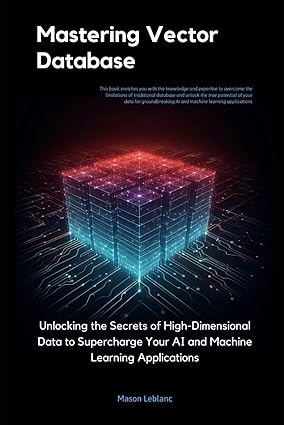In the era of big data and advanced AI, the ability to efficiently store, manage, and query high-dimensional data is paramount. Vector databases, specifically designed to handle numerical data represented as vectors, have emerged as a powerful tool for a wide range of applications, including natural language processing, computer vision, recommendation systems, and anomaly detection.
Mastering Vector Databases: Unlocking the Secrets of High-Dimensional Data to Supercharge Your AI and Machine Learning Applications
Introduction
In the era of big data and advanced AI, the ability to efficiently store, manage, and query high-dimensional data is paramount. Vector databases, specifically designed to handle numerical data represented as vectors, have emerged as a powerful tool for a wide range of applications, including natural language processing, computer vision, recommendation systems, and anomaly detection.
This white paper aims to provide a comprehensive overview of vector databases, exploring their key concepts, architectures, use cases, and best practices. By understanding the intricacies of vector databases, you can harness their potential to supercharge your AI and machine learning applications.
Understanding Vector Databases
What is a Vector Database? A vector database is a specialized database optimized for storing and retrieving high-dimensional numerical data represented as vectors. These vectors can represent various types of data, such as images, text, audio, and more. By storing data in a vector format, vector databases can efficiently perform similarity search operations, which are crucial for many AI and machine learning tasks.
Key Concepts
- Vectors: Numerical representations of data points in a high-dimensional space.
- Similarity Search: Finding the most similar vectors to a given query vector.
- Indexing: Creating data structures to optimize similarity search performance.
- Dimensionality Reduction: Reducing the dimensionality of vectors to improve efficiency and accuracy.
Vector Database Architectures
There are several architectural approaches to vector databases:
- In-Memory Vector Databases: These databases store all data in memory for fast access but may have limitations in terms of scalability and persistence.
- Disk-Based Vector Databases: These databases store data on disk, allowing for larger datasets but potentially sacrificing performance.
- Hybrid Vector Databases: These databases combine in-memory and disk-based storage to balance performance and scalability.
- Distributed Vector Databases: These databases distribute data across multiple nodes to handle large-scale workloads.
Use Cases of Vector Databases
Vector databases have a wide range of applications in AI and machine learning:
- Natural Language Processing: Semantic search, text classification, and question answering.
- Computer Vision: Image search, object recognition, and image generation.
- Recommendation Systems: Personalized recommendations based on user preferences and behavior.
- Anomaly Detection: Identifying unusual patterns in data.
- Drug Discovery: Identifying potential drug candidates based on molecular similarity.
Best Practices for Using Vector Databases
- Choose the Right Architecture: Select an architecture that aligns with your specific needs in terms of performance, scalability, and persistence.
- Optimize Indexing: Experiment with different indexing techniques to find the best balance between performance and storage efficiency.
- Consider Dimensionality Reduction: If your data has a high dimensionality, consider using techniques like PCA or t-SNE to reduce it without compromising accuracy.
- Evaluate Similarity Metrics: Choose appropriate similarity metrics (e.g., Euclidean distance, cosine similarity) based on the nature of your data and the specific task.
- Monitor Performance: Continuously monitor the performance of your vector database and optimize as needed.
Reference List
- Faiss: A Facebook AI Similarity Search Library: https://github.com/spotify/annoy
- Milvus: A High-Performance Vector Similarity Search Engine: https://www.pinecone.io/
- Weaviate: A NoSQL Graph-Based Vector Search Database: http://arxiv.org/pdf/2310.11703
- Understanding Vector Databases: A Comprehensive Guide:IAS
- IAS-Research- RAG Application Development - https://www.ias-research.com/index.php/softengg/machine-learning
Conclusion
Vector databases have become indispensable tools for AI and machine learning applications that deal with high-dimensional data. By understanding their key concepts, architectures, use cases, and best practices, you can effectively leverage their power to unlock valuable insights and drive innovation. contact keencomputer.com for details.
